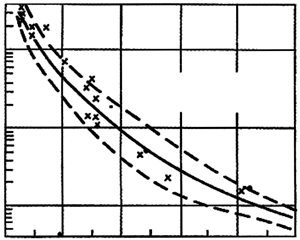Substantiation of requirements to the wavelength of radar monitoring for hydrometeorological purposes
DOI:
https://doi.org/10.3103/S0735272716070049Keywords:
radar monitoring of the atmosphere, wavelengths, attenuation, radar fieldAbstract
Analysis of electromagnetic waves propagation of various wavelengths in the cloudy and cloudless atmosphere is presented. Attenuation of 0.8, 3.2, 5.6 and 10.0 cm radio waves in the clouds of various forms, different water content and temperatures is demonstrated. Based on the frequence and intensity of the hazards, zoning of Ukraine territory has been carried out. We have performed the substantiation of utilization of 0.8, 5.6, and 10.0 cm wavelengths for radar sounding of the atmosphere in the context of the climate and synoptic monitoring. The recommendations are given on the placement of radar stations of different frequency bands in order to meet the needs for information product of the civil and departmental aviation.References
- Towards an integrated global observing strategy: 1997 CEOS Yearbook. Committee on Earth Observation Satellites. European Space Agency. Paris: Smith System Engineering Limited, 1997, 145 p.
- The Instruments and Methods of Observation Programme (IMOP) sets technical standards, quality control procedures and guidance for the use of meteorological instruments and observation methods in order to promote development documentation and world-wide standardization, http://www.wmo.int/pages/prog/www/IMOP/IMOP-home.html.
- Data reception from weather radars of ROSHYDROMET, Ukraine and Belarus, http://orm.mipt.ru:8000/radars.
- GIFT, G.A. Use of radar in meteorology. WMO No. 625, (Technical Note No. l81), 1985.
- DANOVA, T.E.; KASADZHIK, T.L. Spatial-temporal distribution of precipitations in the territory of Ukraine under the conditions of modern climate change. Visnyk V. N. Karazin Kharkiv National University, Ser. Geology, Geography, Ecology, 2013, n.38, p.101-109.
- LOGVINOV, K.T.; BABICHENKO, V.N.; KULAKOVSKAYA, M.Y. Hazardous Weather Phenomena in Ukraine. Leningrad: Gidrometeoizdat, 1972 [in Russian].
- DANOVA, T.E. Influence of modern climatic changes on the dynamics of processes of mezzo scale. Izv. Vyssh. Uchebn. Zaved., Severo-Kavkazskiy Region. Estestvenniye Nauki, 2013, n.3, p.79-83.
- DANOVA, T.E.; PERELYGIN, B.V. Frequence of natural weather phenomena in the region of the North coast of the Black Sea. Proc. of the 2-nd Int. Sci. Conf. with elements of scientific school on Innovative Methods and Research Tools in the Area of Atmospheric Physics, Hydrometeorology, Ecology and Climate Change, 21-25 Sept. 2015, Stavropol, Russia. Stavropol: SKFU, 2015, p.153-156.
- HITSCHFELD, W.; MARSHALL, J.S. Effect of attenuation on the choice of wavelength for weather detection by radar. Proc. IRE, Jul. 1954, v.42, n.7, p.1165-1168, DOI: http://dx.doi.org/10.1109/JRPROC.1954.274551.
- SALMAN, E.M. To the problem of optimal wavelength of the radar for the detection of precipitations clouds. Tr. GGO, 1960, n.102, p.94-203.
- ABSHAEV, M.T.; DADALI, Y.A. On the possibilities of radar examination of the microstructure of clouds and precipitations. Tr. Vysokogornogo Geofizicheskogo Instituta, 1966, n.5, p.124-132.
- SULAKVELIDZE, G.L.; ABSHAEV, M.T. Measurement of the precipitation intensity using multi-radar. Tr. Vysokogornogo Geofizicheskogo Instituta, 1968, n.11, p.198-214.
- ABSHAEV, M.T.; DADALI, Y.A. On the optimal wavelengths of radars of the meteorological application. Tr. Vysokogornogo Geofizicheskogo Instituta, 1969, n.14, p.199-214.
- AYVAZYAN, G.M. Propagation of Millimeter and Submillimeter Waves in the Clouds. Leningrad: Gidrometeoizdat, 1991 [in Russian].
- VESELOVSKA, A.B.; VOYTOVICH, O.A.; LINKOVA, A.M.; KHLOPOV, G.I. Dual-frequency sensing of water drops of ellipsoidal form. Telecom. Radio Eng., 2013, v.73, n.13, p.1153-1163, DOI: http://dx.doi.org/10.1615/TelecomRadEng.v73.i13.30.
- VESELOVSKA, G.B.; KHLOPOV, G.I. On scattering cross-section calculation accuracy of nonspherical particles of rain precipitation using the dipole scattering approximation. Radioelectron. Commun. Syst., 2014, v.57, n.5, p.189-196, DOI: http://dx.doi.org/10.3103/S073527271405001X.
- ABSHAEV, M.T.; BURTSEV, I.I.; VAKSENBURG, S.I.; SHEVELA, G.F. Guidance on the Utilization of Radars MRL-4, MRL-5, MRL-6 in the Hail Protection System. Leningrad: Gidrometeoizdat, 1980 [in Russian].
- LINKOVA, A.M. Use of microstructure parameters for data processing of double frequency measurement of rain intensity. Telecom. Radio Eng., 2012, v.71, n.5, p.423-433, DOI: http://dx.doi.org/10.1615/TelecomRadEng.v71.i5.40.
- Advanced Weather Radar Systems 1993–1997. Final Report. ESSEM COST Action 75 (2001), ISBN/ISSN: 978-92-828-6712-9, http://www.cost.eu/domains_actions/essem/Actions/75.
- Report of research work No. 0113U000164. The improvement of development techniques of obtaining and processing of measurement information for the monitoring of environment: scientific technical report. Odesa: Odesa State Ecological University, 2013, 2014.
- Guidance for the Global Observing System WMO-No 488. 2010 ed., updated in 2012, 184 p.
- STEPANENKO, V.D. Radiolocation in Meteorology. Leningrad: Gidrometeoizdat, 1973 [in Russian].
- Attenuation in atmospheric gases. Recommendations ITU-R P.676-6 The ITU Radiocommunication Assembly (Question ITU – R 201/3 1990-1992-1995-1997-1999-2001-2005), http://www.itu.int/dms_pubrec/itu-r/rec/p/R-REC-p.676-6-200503-S!!PDF-R.pdf.
- BAZLOVA, T.A.; BOCHARNIKOV, N.V.; BRYLEV, G.B. ET AL. Meteorological Automated Radar Networks. St. Petersburg: Gidrometeoizdat, 2002 [in Russian, ed. by G. B. Brylev].
- IPCC 2007. Climate change. 2007: The Physical Science Basis. Summary for Policy Makers. Cambridge–New York: Cambridge University Press, 2007, 996 p.

Downloads
Published
2016-07-17
Issue
Section
Research Articles

